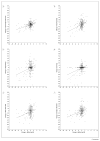Responsiveness of the National Eye Institute Visual Function Questionnaire to changes in visual acuity: findings in patients with subfoveal choroidal neovascularization--SST Report No. 1
- PMID: 12695250
- PMCID: PMC1434793
- DOI: 10.1001/archopht.121.4.531
Responsiveness of the National Eye Institute Visual Function Questionnaire to changes in visual acuity: findings in patients with subfoveal choroidal neovascularization--SST Report No. 1
Erratum in
- Arch Ophthalmol. 2003 Oct;121(10):1513
Abstract
Background: The National Eye Institute Visual Function Questionnaire (NEI-VFQ) measures vision-targeted quality of life, but it is unclear whether it is sensitive to changes within individuals over time.
Objective: To determine the responsiveness of the NEI-VFQ to "within-individual" changes in visual acuity in patients who had subfoveal choroidal neovascularization in at least one eye secondary to age-related macular degeneration, ocular histoplasmosis syndrome, or idiopathic causes, and who participated in randomized trials of submacular surgery.
Methods: Trained telephone interviewers administered the NEI-VFQ as part of annual follow-up data collection for pilot trials and larger clinical trials of submacular surgery. Best-corrected visual acuity was measured by local vision examiners at 12 months after enrollment and, typically, by central "traveling" vision examiners at 24 months after enrollment. Changes in visual acuity and NEI-VFQ scores from 12 to 24 months were analyzed using linear regression methods.
Results: Two-hundred eighteen patients had both interviews and visual acuity measurements at 12 and 24 months after enrollment. Changes in the overall NEI-VFQ score and in 9 of the subscales (near activities, dependency, driving, role difficulties, distance activities, mental health, general vision, peripheral vision, and social functioning) were related to changes in visual acuity of the better-seeing eye based on linear regression analysis (P<.05). In our analysis, a 3-line decrease in the visual acuity of the better-seeing eye was associated with 3.6- to 16.2-point decreases in the overall NEI-VFQ score and 9 subscale scores.
Conclusions: Most of the NEI-VFQ subscales were responsive to changes in the visual acuity of the better-seeing eye over a 12-month interval in this patient population. Thus, the NEI-VFQ can be used to measure change in vision-targeted quality of life over time to augment clinical measurements of visual acuity.
Figures




References
-
- Mangione CM, Berry S, Spritzer K, et al. Identifying the content area for the 51-item National Eye Institute Visual Function Questionnaire: results from focus groups with visually impaired persons. Arch Ophthalmol. 1998;116:227–233. - PubMed
-
- Mangione CM, Lee PP, Pitts J, et al. Psychometric properties of the National Eye Institute Visual Function Questionnaire (NEI-VFQ) Arch Ophthalmol. 1998;116:1496–1504. - PubMed
-
- Mangione CM, Lee PP, Gutierrez PR, et al. Development of the 25-item National Eye Institute Visual Function Questionnaire. Arch Ophthalmol. 2001;119:1050–1058. - PubMed
-
- Broman AT, Munoz B, West SK, et al. Psychometric properties of the 25-item NEI-VFQ in a Hispanic population: proyecto VER. Invest Ophthalmol Vis Sci. 2001;42:606–613. - PubMed
-
- Cole SR, Beck RW, Moke PS, Gal RL, Long DT the Optic Neuritis Study Group. The National Eye Institute Visual Function Questionnaire: experience of the ONTT. Invest Ophthalmol Vis Sci. 2000;41:1017–1021. - PubMed

